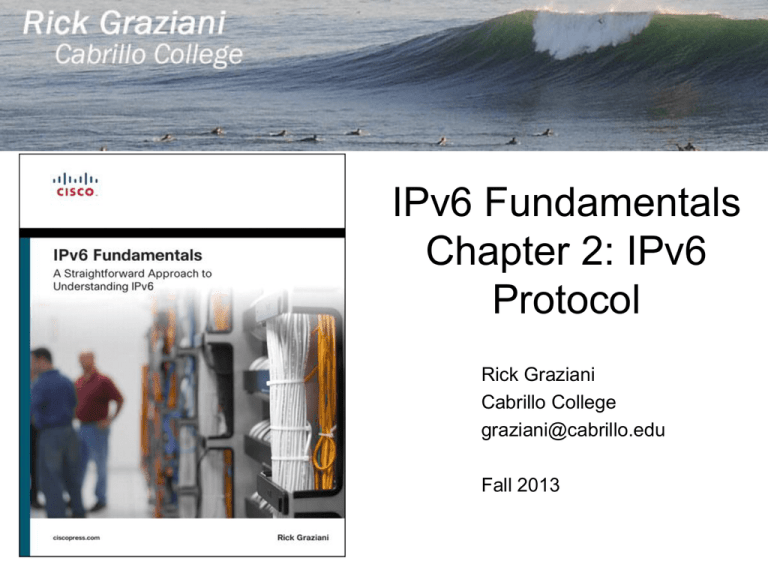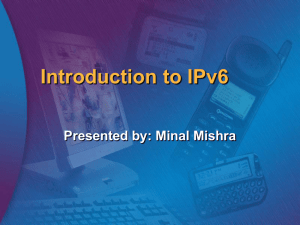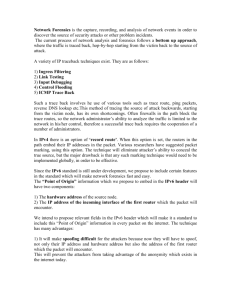Next Header - Cabrillo College
advertisement

IPv6 Fundamentals Chapter 2: IPv6 Protocol Rick Graziani Cabrillo College graziani@cabrillo.edu Fall 2013 Objectives This chapter describes the IPv6 header by comparing it with the IPv4 header. It examines the fields in the IPv4 header Explores both the similarities and the differences between IPv4 and IPv6 headers. In addition to the main IPv6 header, a new type of IPv6 header known as an Extension header is also examined. The end of this chapter contains a summary that includes the differences between the IPv4 and IPv6 headers.. 2 IPv4 Header To help you better understand the IPv6 header and its enhancements over IPv4, we will first take a look at the IPv4 header. 3 Version (4 bits): The version number of the IP (Internet Protocol) header. In IPv4, this field is always the value of 4. Internet Header Length (4 bits): Length of the IP header in 32-bit words, including any optional fields. Where the IP header ends and the data or payload begins. The minimum value is 5 (5 * 32-bit words = 160 bits or 20 octets [bytes]). This is equal to the minimum size of an IPv4 header, excluding any options or padding. 4 Type of Service (8 bits): Specifies what type of treatment the packet should receive from routers. Helps provide quality of service (QoS) features by offering different degrees of precedence. The ToS field was not widely used as originally designed, so in 1998, the Internet Engineering Task Force (IETF) redefined it further in RFC 2474 using a technique called Differentiated Services (DS). Differentiated Services Code Point (DSCP) is discussed in more detail later in this chapter, but ToS and DS are beyond the scope of this book. 5 Total Length (16 bits): (1 of 2) Length of the IP packet, measured in octets (bytes), including the IP header and the data. 16-bit field, so maximum size of an IPv4 packet is 65,535 bytes. Most IPv4 packets are much smaller. The next three fields are used for packet fragmentation and reassembly. 6 Total Length (16 bits): (2 of 2) IP was designed for a wide variety of transmission links. Most transmission links enforce a maximum packet length known as the MTU (maximum transmission unit). IPv4 accommodates MTU differences by allowing routers to fragment IP packets when an MTU along the path is smaller than the sender’s MTU. If a router receives an IPv4 packet that is larger than the MTU of the outgoing interface, this packet can be fragmented depending upon the options in the IPv4 header. Sometimes packets are fragmented into multiple packets at the source. The final destination of the IP packet is responsible for reassembling the fragments into the original full-size IP packet. 7 Identification (16 bits): Most messages sent over the network consist of many packets. Each packet within the message has a unique value using this 16-bit Identification field. When a packet needs to be fragmented, this Identification field is common in all the fragmented packets Helps the receiver in reassembling these fragments. 8 IP Fragmentation The The outgoing outgoing link link has has a a large enough MTU but to I smaller MTU so I have don’t reconstruct fragment the packets. packets. It is my job to reconstruct the packets. IP Packet IP Packet Network link with larger MTU IP Packet IP Packet IP Packet Network link with smaller MTU Network link with larger MTU IP Packet IP Packet IP Packet IP Packet IP Packet IP Packet When fragmentation occurs, it does not get reconstructed until it reaches the host. This takes processing time. Fragment Offset field identifies the order 9 Flags (3 bits): The first bit is 0, which means it is reserved or not used. The second bit is known as the DF, or Don’t Fragment, bit. Set to 1, packet should not be fragmented. However, most protocols don’t care about the fragmentation process and set this flag to 0. This means that this packet can be fragmented if needed. The third bit is the More Fragments Flag Indicates whether this is the last fragment (0 bit) or whether there are more fragments to follow (1 bit). If a packet is not fragmented, there is only one fragment—the entire packet—this flag is set to 0. 10 Note The DF flag is very useful when testing the MTU of a path between the source and the destination. If the DF flag is set to 1, the packet should not be fragmented. Any router along the path whose MTU is smaller than the packet will drop the packet and send an Internet Control Message Protocol (ICMP) “Destination Unreachable” message back to the source. The ICMP message will include the MTU of the router’s egress interface. RFC 1191, Path MTU Discovery, explains this process if you are interested in learning more. 11 Fragment Offset (13 bits): When a packet is fragmented, this field specifies the offset or position where this data goes in units of 8 octets (64 bits). Notifies the receiver where to align this fragmented packet in relation to the other fragmented packets. 12 Time to Live (8 bits): Ensures that packets do not live in the network for an indefinite period of time as in the case of a routing loop. Decremented by 1 each time a router receives the packet. When the field contains the value of 0, the packet is discarded ICMPv4 Time Exceeded (Type 11) message is sent to the source. Note: TTL originally intended to represent the actual maximum amount of time that the packet is allowed to traverse the network. RFC 791 stated, “Even if no local information is available on the time actually spent, the field must be decremented by 1. The time is measured in units of seconds (i.e., the value 1 means one second). Thus, the maximum time to live is 255 seconds or 4.25 minutes.” Instead of calculating the amount of time, routers just decrement the TTL by 1, in effect making it the number of hops. 13 Protocol (8 bits): Indicates the protocol carried in the data portion of the IP packet. The values for various protocols are specified in RFC 1700, Some of the more common values are 1 for ICMP, 6 for TCP, and 17 for UDP. Header Checksum (16 bits): Provided for protection against any corruption in transit. This is not the more complex CRC (Cyclic Redundancy Check) used by Ethernet but a much simpler 16-bit checksum performed only on the IP header. Each router along the path verifies and recomputes this field. If the checksum fails, the router discards the packet. 14 Source Address (32 bits): 32-bit IP address of the originator of the packet. Destination Address (32 bits): 32-bit IP address of the final destination or recipient of the packet. Used by routers to forward the packet along its path toward its ultimate destination. Note: Network Address Translation (NAT) can change either the source or destination address to one of the translator’s addresses, typically an RFC 1918 private IP address. 15 Options (variable length): Optional, so it might or might not appear in the IP packet. Variable in size and not included in most packets. Some of the options contain record route, timestamp, and traceroute used as an enhancement to the traceroute utility and described in RFC 1393, Traceroute Using an IP Option. Padding (variable length): If one or more options are used, and the size of the IP header is no longer a multiple of 32 bits, 0 bits are added to pad out the header so that it ends on a 32-bit boundary. 16 Data (variable length): The data to be transmitted in the IP packet and identified by the Protocol field. The data can be another Layer 3 protocol such as ICMP, or a higher-layer protocol such as TCP or UDP. 17 IPv6 Header Basic structure of the IPv6 header or what is sometimes referred to as the main IPv6 header. The main IPv6 header can also include one or more IPv6 extension headers. Extension headers are explained later. 18 Version (4 bits): This field contains the version number of the IP (Internet Protocol) header. In IPv6, this field is always the value of 6. Traffic Class (8 bits): This field has similar functions to the Type of Service (ToS) field in the IPv4 header. It is the same size as the IPv4 ToS field; only the name has changed. IPv6 uses the Differentiated Services technique specified in RFC 2474, Definition of the Differentiated Services Field (DS Field) in the IPv4 and IPv6 Headers. ToS and DSCP are not covered in CIS 187 CCNP SWITCH 19 Flow Label (20 bits): The Flow Label field is used to tag a sequence or flow of IPv6 packets sent from a source to one or more destination nodes. Predecessor to MPLS This flow can be used by a source to label sequences of packets for which it requests special handling by the IPv6 routers, such as “real-time” service. The Flow Label field is used to help identify all the packets within the same flow to ensure that all the packets receive the same type of handling by the IPv6 routers. Flow Label usage is described in RFC 6437, IPv6 Flow Label Specification. This field is still somewhat experimental 20 Payload Length (16 bits): (1 of 2) Length in octets of the payload following the main IP header or, in other words, the data portion of the packet. Including if the IPv6 packet has one or more extension headers. Similar to the Total Length field in the IPv4 header, except for one important difference. IPv4 Total Length field includes both the IPv4 header and the data IPv6 Payload Length field only specifies the number of bytes of data (not the IPv6 header) The IPv4 header can vary in length because of Padding and Options fields, whereas the IPv6 header is fixed at 40 bytes. 21 Payload Length (16 bits): (2 of 2) The Payload Length field is 16 bits, allowing a maximum payload size of 65,535 bytes. IPv6 has a Jumbogram extension header to support larger packet sizes if needed. RFC 2675, IPv6 Jumbograms, specifies an additional 32-bit field to allow the transmission of IPv6 packets with payloads between 65,536 and 4,294,967,295 bytes. Extension headers along with the Jumbo Payload Options are discussed later in this chapter. 22 Next Header (8 bits): This field has two benefits. When there is only the main IPv6 header and no extension headers, the Next Header field specifies the protocol carried in the data portion of the IPv6 packet. This is similar to the Protocol field in the IPv4 header. The same values used in the IPv4 Protocol field are used in the IPv6 along with additional values. Also specifies when there is an Extension header (coming). 23 Figure 2-4 Next Header field Next Header 6 IPv6 Header Next Header 17 IPv6 Header Next Header 58 IPv6 Header TCP Header TCP Data IPv6 Data UDP Header UDP Data IPv6 Data ICMPv6 Header ICMPv6 Data IPv6 Data Hop Limit (8 bits): Equivalent to the Time to Live (TTL) field in the IPv4 header. Name more reflective of the way that routers treat this field by decrementing the hop limit by 1. Just as with the IPv4 TTL field, if the router decrements the hop limit from 1 to 0, the packet is discarded. In IPv6, an ICMPv6 Time Exceeded message (Type 3, Code 0) is sent to notify the source of the packet that the packet has been dropped. 25 Source Address (128 bits): 128-bit IP address of the originator of the IPv6 packet. The source address must be a unicast address. Destination Address (128 bits): 128-bit IP address of the intended final destination or recipient of the IPv6 packet. Can be a unicast or multicast address. Unlike IPv4, there is no broadcast address; however, there is an all-nodes multicast address. 26 Extension Headers Next Header 0 Main IPv6 Header Next Header 51 Next Header 6 Hop-By-Hop Authentication Extension Header Extension Header TCP Header TCP Data IPv6 Data Extension headers are optional and follow the main IPv6 header. IPv6 header includes a Next Header field, which has one of two purposes: 1. To identify the protocol carried in the data portion of the packet 2. To identify the presence of an extension header. 27 Next Header 0 Main IPv6 Header Next Header 51 Next Header 6 Hop-By-Hop Authentication Extension Header Extension Header TCP Header TCP Data IPv6 Data 28 Next Header 0 Main IPv6 Header Next Header 51 Next Header 6 Hop-By-Hop Authentication Extension Header Extension Header TCP Header TCP Data IPv6 Data Intention of extension headers is to provide flexibility to the main IPv6 header for future enhancements without having to redesign the entire protocol. This also allows the main IPv6 header to have a fixed size for more efficient processing. 29 Next Header 0 Main IPv6 Header Next Header 51 Next Header 6 Hop-By-Hop Authentication Extension Header Extension Header TCP Header TCP Data IPv6 Data The main IPv6 header has a Next Hop field with the value of 0, indicating that a Hop-by-Hop extension header immediately follows. The Hop-by-Hop extension header follows the main IPv6 header. Extension headers contain their own Next Header field. Its value of 51 signifies that there is yet another extension header to follow, the Authentication Header (AH). The final extension header is the Authentication Header. Its Next Header field has a value of 6, indicating that a TCP upper-layer header is to follow. This also means that there are no more extension headers in this packet. 30 For more about Extension Headers… If you are interested, I have an entire section in this chapter that explains Extension headers and gives some examples. 31 IPv4 and IPv6 Header Comparisons After examining the details of the IPv4 and IPv6 headers, it’s easy to miss some of the important differences between the two protocols. There was a lot of information to digest, so let’s summarize some of these differences. 32 These IPv4 field names are the same as those in IPv6: Version (IPv4 and IPv6): This is an easy one… Value is 4 in IPv4 and 6 in IPv6 Source Address and Destination Address (IPv4 and IPv6): Probably the most noticeable differences are the 32-bit IPv4 source and destination addresses, which have been increased to 128 bits in IPv6. 33 IPv4 field names changed in IPv6 with functional differences in some cases: Type of Service (IPv4) ➞ Traffic Class (IPv6): IPv4 can use either the 3-bit IP Precedence field along with another 3 bits for delay, throughput, and reliability, or the 6-bit Differentiated Services technique. IPv6 was designed to use the 6-bit DS method. Total Length (IPv4) ➞ Payload Length (IPv6): IPv4’s Total Length field includes both the IPv4 header and the data. IPv6 Payload Length field only specifies the number of bytes of data (payload), including any extension headers, and does not include the main IPv6 header. 34 IPv4 field names changed in IPv6 with functional differences in some cases: Time to Live (IPv4) ➞ Hop Limit (IPv6): This has the same function in both IPv4 and IPv6, with the name being more reflective of its actual use in IPv6. Protocol (IPv4) ➞ Next Header (IPv6): In IPv4, this indicates the protocol being carried in the IPv4 data or payload. In IPv6, same function exists in the Next Header field but can also indicate the existence of an extension header following the main IPv6 header. 35 IPv4 fields removed from IPv6: Internet Header Length (IPv4): Not needed in IPv6 because the main IPv6 header has a fixed length of 40 bytes. Any additional headers are linked as indicated in the Next Header field. Identification (IPv4), Flags (IPv4), and Fragment Offset (IPv4): These fields are used for fragmentation in IPv4. Fragmentation is handled differently in IPv6 using the Fragment extension header. 36 IPv4 fields removed from IPv6: Header Checksum (IPv4): Layer 2 data link layer technologies such as Ethernet perform their own checksum and error control. Upper-layer protocols such as TCP and UDP also have their own checksums and therefore a checksum at Layer 3 becomes redundant and unnecessary. A UDP checksum, which is optional in IPv4, is mandatory in IPv6. 37 IPv4 fields removed from IPv6: Options (IPv4): Options in IPv4 are now handled using extension headers in IPv6. Two IPv6 extension headers, Hop-by-Hop Options and Destination Options, contain their own set of TLV options. Padding (IPv4): Because IPv6 has a fixed length of 40 bytes, it is unnecessary to extend the header to make sure that it falls on a 32-bit boundary 38 New field in IPv6: Flow Label (IPv6): This is a new field to IPv6, and the specifications of its use are still being determined by the IETF. RFC 2460 does discuss using the Flow Label field to label sequences of packets for needing special handling by IPv6 routers for “real-time” service. Predecessor to MPLS 39 Other Differences Larger Maximum Transmission Unit (MTU) IPv6 requires that every link have a minimum MTU of 1280 bytes, with a recommended MTU of 1500 bytes, compared to 68 bytes in IPv4.. User Datagram Protocol (UDP) The User Datagram Protocol (UDP) Checksum field in IPv4 is optional. Although the protocol remains the same in IPv6, the Checksum field is mandatory in IPv6. This is because the IPv4 header has its own Checksum field but has been removed in the IPv6 header. The Checksum field is used to verify the integrity of the UDP header and data. Fragmentation IPv6 routers do not fragment packets unless the router is the source of the packet. If an intermediate node such as a router receives an IPv6 packet that needs to be fragmented, it will discard the packet and send an ICMPv6 Packet Too Big error message back to the source 40 IPv6 Fundamentals Chapter 2: IPv6 Protocol Rick Graziani Cabrillo College graziani@cabrillo.edu Fall 2013





